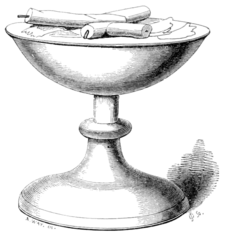various times found in the graves of ecclesiastics, in the Minster: of a similar discovery in the coffin supposed to contain the remains of Henry of Worcester, abbot of Evesham, who died A.D. 1263, an interesting record has been preserved by Mr. Rudge[1], and many other examples might be cited.
In forming a grave in Hereford cathedral, in 1836, a place of sepulture was brought to light, containing human remains, clothed in vestments which had been richly embroidered; at the right side lay a small chalice and paten of white metal, and on the paten were two pieces of wax taper, the wicks partly consumed, placed in the form of a cross. This singular circumstance seemed to indicate a practice, analogous, in some measure, to the deposit of the waxen sigillum, according to the ancient Custumal above mentioned, cited by Martene[2]. The chalice was placed in the hand of the deacon, as a kind of investiture, at his ordination, as represented in the curious subject from the legend of St. Guthlac, given in a former volume of this Journal[3]. The same, possibly, was in many instances placed between the hands of the defunct
- ↑ Archæologia, vol. xx. p. 566.
- ↑ Amongst many other instances of such discoveries may be noticed several chalices found at Chichester, one of which, of singular form, has been assigned to the twelfth century; several found on the site of Hyde Abbey, represented by Carter, in his Sculpture and Painting; also two discovered in the choir at Lich- field, and formerly in Green's Museum. Shaw's Hist. Staff., vol. i. pp. 256, 332.
- ↑ Archæol. Journal, vol. i. p. 286.



